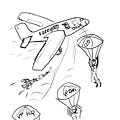In December 2019, the CEO of Boeing is fired following the incidents related to safety program failures leading up to 737 MAX aircraft fatalities. More recently, the head of the 737 Max program is fired. Some citizens taking advantage of commercial air travel may wonder if these actions solve what they see as a compromised commercial air travel safety program.1 In my opinion, the leadership changes, whether they come directly from the Boeing Board of Directors or indirectly from the FAA, may not be the answer to perceived safety breakdowns at Boeing.
That is, what has been the effect on organizational safety culture?
Safety culture & engineered protections
Efficacious safety culture programs are required in design, operation, and maintenance of complex technical undertakings such as commercial air travel and commercial nuclear power for example.
Safety culture in these two examples has historically been driven by unyielding engineering practice in design, operation, and maintenance of protection systems. Sometimes protection systems are called '“safety systems” but for the most part, they are the subject of regulatory oversight.
Commercial enterprises in complex technical undertakings often find themselves at odds with engineers who will not compromise their utility on safety. The same is true of their relationship with the regulator. That is, the engineers who are concerned they may be responsible for an accident due to a failure in vigilance likely hold different views on what is required for “safe” protections. The engineer’s perspective is driven by engineering knowledge, experience, and training, while the business executive’s perspective comes from revenue compared to the cost of (engineered) protections—return on investment. Commercial enterprises therefore require an arbitrator to settle differences in the two perspectives that would reconcile differing perspectives to the advantage of citizens’ health and welfare.
Safety culture, the enterprise, and the regulator
Unrestrained by any other influence, the enterprise will ultimately land on cost as the primary consideration on protection. This is not to mean that there are no constraints on protection.
Liability is a cost concern to the extent profits are maximized. That is, absent any other influences, liability exposure is typically balanced against profit. At a high level, it could be said that to the extent insurance premiums can be offset by cost of protections, protections would be added.
So again, the utility on safety held by the engineer responsible for design and operation of systems that could harm citizens differs from the utility held by the business executive. Regulatory actions can intervene to the benefit of citizens’ health and safety. An effective action by the regulator is to require the enterprise adopt a “culture of safety”. An example is the NRC Safety Culture Policy Statement.
The [USNRC] Safety Culture Policy Statement (76 FR 34773; June 14, 2011) sets forth the Commission's expectation that individuals and organizations establish and maintain a positive safety culture commensurate with the safety and security significance of their activities and the nature and complexity of their organizations and functions.
Although the NTSB and especially the FAA may have a safety culture policy, it is not clear what steps they have taken to implement the policy. Looking for a policy statement it seems they have commissioned a literature review.
Recent events in the airline industry may indicate it is time for the NTSB to have a think about the meaning of safety culture and do something about it. Of particular interest is whether the changes being made at the upper levels of the Boeing company will result in a sea change in the company’s safety culture.
That is, will the company return to a policy that relies on uncompromising engineering judgement of requirements for proper protections or simply change management for appearances?
What about the risk?
The company, the NTSB, and the FAA repeatedly make the assertion that air travel is safer than private automobile transportation. Deflecting responsibility for doing the right thing when air travel safety is seen to be compromised with such assertions is insulting to the citizens who have asked for the highest standards of protections in air travel. Managing risk in air transportation requires a focus on safety by both the regulator and the enterprises engaged in providing air travel solutions. Kicking out and replacing management might make some feel good. But unless a sea change is realized in enterprise safety culture, changing management amounts to a change without a difference.
To read more of Ernie ‘s writing and research, go to Ernie ‘s newsletter or ORCiD.
This article originally appeared in Ernie ‘s Newsletter, a substack by Ernie Kee.
1Other incidents in recent news: Missing bolts in Airbus flight, Passenger sees wing failing.



